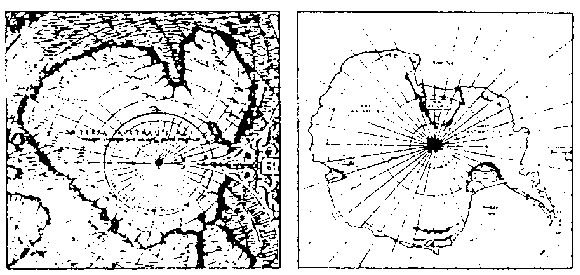 |
Science Frontiers ONLINE No. 49: Jan-Feb 1987 |
|
|
Those Old Maps Of Antarctica
Was Antarctica nearly ice-free within the last few thousand years? Did the old navigators sail into these now-frigid waters and map this great southern continent? One way to answer such questions is by turning to old maps and, then, asking the geophysicists if most of the continent's ice cover could have disappeared fairly recently, as some ancient maps are purported to show.
C.P. Hapgood, well known for his book Maps of the Ancient Sea Kings, believed that ancient mariners did indeed map Antarctica when those climes were warmer. More recently, J.G. Weihaupt came to similar conclusions by a different route, which included geophysical considerations. (See SF#36 and #38.) Now, D.C.Jolly has put the whole problem in perspective in an excellent review.
Jolly has studied the data in depth, as indicated by his 51 sources. In his view, it boils down to the fact that the old maps, which people of all persuasions use, are often incomplete and ambiguous. One can read a lot into them. To claim an ice-free Antarctica, one has only to make a few assumptions. For example, one reduces the size of a map feature here and rotates another there. It seems that those old map-makers didn't get things quite right! Jolly is fair about the whole business and even admits his admiration for Hapgood. In part, his conclusions are:
"Our knowledge of early cartography is limited, since much of the material from the sixteenth century is now lost. While this affords ample opportunity for speculation, there have been many scholarly studies of this period. These studies were not done by dunces, but by individuals who spent years acquiring the skills and perception necessary to interpret the evidence. Professor Hapgood, to his credit, spent almost ten years studying the evidence and consulting experts in the field. His ideas were rejected in scholarly circles not because of animus but because he had not proved his case. Too many leaps of faith were needed to establish his thesis. I fear it is impossible to be equally charitable toward some later advocates of the Hapgood thesis, whose methods do little credit to his memory."
(Jolly, David C.; "Was Antarctica Mapped by the Ancients," Skeptical Inquirer, 11:32, 1986.)
 | Antarctica is in the eye of the beholder. Do these two maps show the same thing? Note that the Finaeus map (1531) (left) would be much larger than the modern map (right) if the scales were equal. |